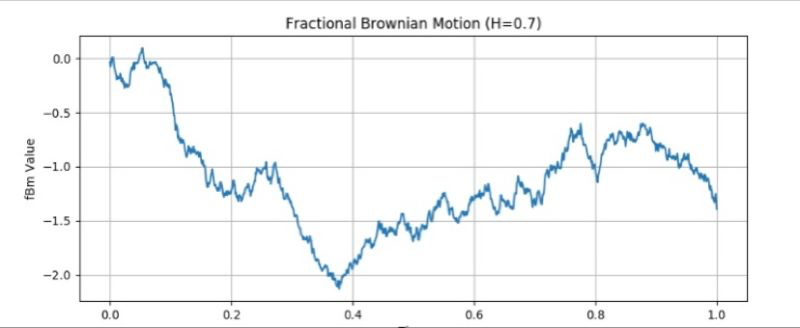Fractional Brownian Motion (fBm) is a versatile mathematical concept applied across disciplines like finance, physics, and signal processing. In essence, it extends the classical Brownian motion, which describes the random movement of particles in a fluid.
Brownian motion features particles moving randomly and continuously, with each step unrelated to the previous one, creating a smooth path.
Contrasting this, fractional Brownian motion introduces variability in volatility over time, governed by a parameter known as the Hurst parameter (H). This parameter, ranging between 0 and 1, determines the roughness or smoothness of the path:
H = 0.5 corresponds to standard Brownian motion with constant volatility.
H < 0.5 signifies anti-persistent behavior, where significant changes tend to be followed by smaller ones, introducing some predictability.
H > 0.5 indicates persistent behavior, where significant changes are more likely to be followed by further significant changes, making predictions less straightforward.
Fractional Brownian motion exhibits self-similarity, meaning that zooming in on any portion of the path reveals patterns resembling the entire path. This property makes it suitable for modeling phenomena with long-range dependencies.
In various fields, including finance, fractional Brownian motion proves invaluable. Financial markets experience varying volatility levels, and fBm adeptly captures changing volatility patterns. It aids in developing precise models for asset price volatility, critical for options pricing, risk management, and trading strategies. fBm offers insights into market behavior under different volatility conditions.
Beyond finance, fBm finds utility in physics and signal processing. It helps analyze complex data with long-term memory, simulate natural phenomena with fractal-like characteristics, and study systems with intricate dynamics.
In summary, fractional Brownian motion is a versatile tool that extends random motion by allowing variable volatility, introducing the Hurst parameter to control chaos, and finding applications in diverse fields, from finance to science. It facilitates the modeling, analysis, and understanding of phenomena featuring changing patterns and long-range dependencies.


Écrire commentaire